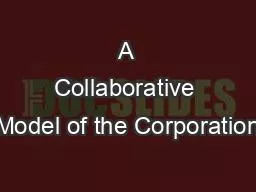

Jill E Fisch Simone M Sepe Two Models of the Corporation Managementpower model Berle amp Means Director Primacy Shareholderpower Both models are essentially confrontational or competitive ID: 788974
Download The PPT/PDF document "A Collaborative Model of the Corporation" is the property of its rightful owner. Permission is granted to download and print the materials on this web site for personal, non-commercial use only, and to display it on your personal computer provided you do not modify the materials and that you retain all copyright notices contained in the materials. By downloading content from our website, you accept the terms of this agreement.
Slide1
A Collaborative Model of the Corporation
Jill E. FischSimone M. Sepe
Slide2Two Models of the Corporation
Management-power modelBerle & MeansDirector PrimacyShareholder-powerBoth models are essentially confrontational or competitive
Slide3The Language of Confrontational Theories of Corporate Governance
Takeover battlesContests for corporate controlWhite knights & poison pillWarWolf packs
Slide4The Alternative – Insider/Shareholder Collaboration
Descriptively collaboration is consistent with the prevailing structure of corporate lawCollaboration is also consistent with private orderingOur paper offers a normative justification for collaboration in terms of increasing firm economic value Several implications follow
Slide5A Positive View of Collaboration
Private-ordering through corporate charters and bylawsSay on payEngagement between insiders and Institutional investorsActivist investors and longer term operational strategiesAnecdotal examples
Slide6Slide7Slide8How Collaboration increases Firm Value
Economic importance of informationPartial information problemAbility of institutional investors to bring complementary information to corporate decision-makingInterpretive value, not just information-gatheringCollaboration is the most efficient form of information-sharing between and among insiders and shareholders
Slide9An Example
Slide10How to Structure Collaboration – Lessons from Game Theory
Properties of insider-shareholder coalitionsComplementarity of informationSuperaddivityMonotonocityIncentive compatibilityAssignment of economic rights
Based on shareholdings
Assignment of decision-making rights
Shared decision-making structures
Structure and role based on marginal contribution
Structure
Formal contracts (including charter and bylaws)
Relational contracts
Slide11Collaborative Breakdown
and the Risk of Opportunistic BehaviorManagerial EntrenchmentShareholder Short-termismThese risks provide the basis for our regulatory reform proposals
Slide12Implications of the Collaborative Model
A preference for charter-based governance over unilaterally-adopted bylawsBalancing board and shareholder power in takeover defenses and other areasReframing the scope of directors’ confidentiality obligations
Slide13Charters versus bylaws
Applies to rules of the game decisionsFavors joint over unilateral decisionmakingConcernsIPO charter provisionsFrozen charters Possible solutions include sunsetting or shareholder initiation
Slide14Balancing board and shareholder power in takeover defenses
Staggered boards, poison pills, say on pay, special shareholder meetingsPreference for joint control mechanisms to encourage collaborationJoint control also minimizes the risk of self-dealingConcernShareholder use of control to exert leveragePossible solution – time limits, power limits
Slide15Reframing the scope of directors’ confidentiality obligations
Traditional confidentiality obligations mitigate against directors sharing information outside the firmValue of institutional board representation depends on information sharing between the director and his/her fundConcernsCompetition or otherwise hurting firm interestsDamaging leaks
Insider trading
Possible response may be extending fiduciary obligations to funds’ use of confidential firm information
Slide16Conclusion
Time to rethink the insider-shareholder relationship in collaborative termsToday’s institutional shareholders offer the potential to increase firm value Mechanisms to facilitate information-sharing and joint decisionmaking
facilitate the collaborative process